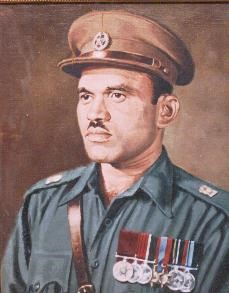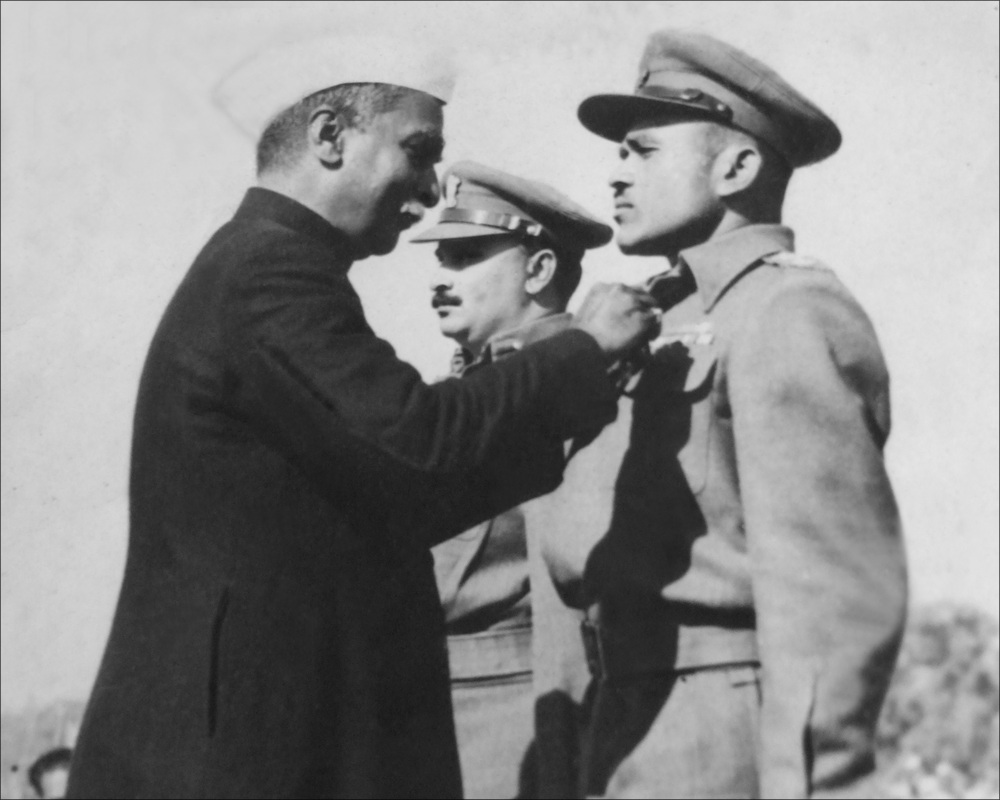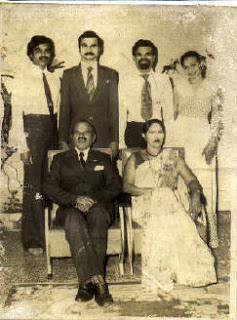Latest Contributions
Read More Contributions
Major Rama Raghoba Rane - Param Vir Chakra Awardee (Number 3)
Category:
The Param Vir Chakra is India's highest military decoration for acts of conspicuous gallantry in the presence of the enemy.
We welcome additional materials about Major Rama Raghoba Rane - pre-Army, in-Army, post-Army - from relatives, friends, colleagues and other people who have relevant materials./p>\;
In the 1980s, Doordarshan commissioned Chetan Anand, a well-known film director, to produce TV episodes (in Hindi) on Param Vir Chakra awardees. The episode on Major Rane is available here.
We also welcome similar materials - for separate stories - about other heroes and martyrs of the Indian Armed Forces, provided the time of the event was at least 30 years ago. Our contact is indiaofthepast@gmail.com
______________
This section is adapted mainly from the official Indian Army account, Bhavin Dabhi's blog, Wikipedia, and Rachna Bisht Rawat's blog

Major Rama Raghoba Rane
Second Lieutenant Rama Raghoba Rane was born on 26 June 1918 at Chendia, Karnataka. His father, R. P. Rane, was a police constable. Since his father was transferred several times, Rane's early education, mostly in district schools, was not smooth.
In 1930, he became interested in the movement for India's independence. This alarmed his father, who moved the family back to their ancestral village at Chendia.
Editor's note: We would greatly appreciaete information about Major Rane's life between 1930 and 1940.
In 1940, when Rane was 22 years old, he enlisted in the Bombay Engineer Regiment, and passed out as the "Best Recruit." After his training, Rane was part of the fight against the Japanese in Myanmar (Burma). He was promoted to havaldar (sergeant) at this time.
In December 1947, he was commissioned in the Corps of Engineers. He retired as a Major in 1968. He passed away in July 1994.
He served with distinction during the 1947-48 Jammu &\; Kashmir operations. On 18 March 1948, the Indian Army recaptured Jhangar, which was lost to the enemy in December 1947. Indian troops then planned an advance from Naushahra to Rajouri to protect the natives from atrocities of the raiders. Halfway lay the Chingas, on the old Mughal route to Kashmir.
The 4 Dogra commenced the advance to Rajauri on 8 April 1948. It attacked the Barwali ridge, 11 km north of Naushahra and captured it after driving out the enemy from well-prepared positions. But beyond Barwali, the increasing number of roadblocks and minefields obstructed the progress of the battalion. Even armour could not cross over these obstacles.
During this critical phase, 2nd Lt. Rane and his section of 37 Assault Field Company, attached to 4 Dogra, performed yeoman service. As the section started clearing a minefield on April 8th, two sappers were killed and five others including Rane were injured in enemy mortar fire. However, Rane and his men completed the work by the evening and enabled the tanks to push forward.
But the enemy had not been cleared from the area, and the road ahead was still unsafe for the advance. 2nd Lieutenant Rane worked during the night to prepare a safe lane for the tanks. On April 9th, his men continuously worked for twelve hours to clear mines and remove roadblocks. Where the road was found un-negotiable, he made a diversion for the column to pass through. 2nd Lieutenant Rane continued this work in the face of enemy artillery and mortar fire.
On April 10th, he woke up early to resume work on the roadblock, which could not be cleared the previous night. He cleared this huge roadblock of 5 big pine trees, surrounded by mines and covered by intensive machine-gun fire, within two hours.
The Army advanced another 13 km on this day before they encountered another major roadblock. The enemy pickets, perched on the adjoining hills, were guarding all approaches to this roadblock. 2nd Lieutenant Rane drove to the roadblock in a tank and crouching under it, blasted the block with mines. He thus opened the road before the end of the night. On April 11th, they worked for 17 hours to open the road to Chingas and beyond.
2nd Lt. Rane made a substantial contribution in facilitating the Indian advance on Rajouri. It cost the enemy about 500 dead and many more wounded. It also helped in saving many innocent lives in Chingas and Rajauri.
The gallant effort made by 2nd Lieutenant Rama Raghoba Rane during this critical advance to Rajauri earned him the Param Vir Chakra.

President Prasad pinning the Param Vir Chakra on 2nd Lieutenant Rama Raghoba Rane

Major Rane with his family.
Param Vir Chakra Citation
On 8 April 1948, Second Lieutenant Rama Raghoba Rane, Bombay Engineers, was ordered to be in charge of the mine and roadblock clearing party at Mile 26 on the Naushera-Rajouri road which passes through very hilly country.
At 1100 hours, on that date near Nadpur South, just as Second Lieutenant Rane and his party were waiting near the tanks to start the work of clearing the mines ahead, the enemy started heavy mortaring of the area, with the result that two men of the mine-clearing party were killed and five others including Second Lieutenant Rane were wounded. The officer at once reorganized his party and started work for the tanks to go on to their position. Throughout the day he was near the tanks under heavy enemy machine-gun and mortar fire.
After the capture of Barwali Ridge at about 1630 hours, although knowing that the enemy had not been completely cleared of the area, Second Lieutenant Rane took his party ahead and started making a diversion for the tanks to proceed. He worked on till 2200 hours that night in full view of the enemy and under heavy machine-gun fire.
On 9 April he again started work at 0600 hours and worked on till 1500hrs when the diversion was ready for the tanks to proceed. As the armoured column advanced, he got into the leading carrier and proceeded ahead. After proceeding about half a mile he came across a roadblock made of pine trees. He at once dismounted and blasted the trees away. The advance continued. Another 300 yards and the same story was repeated. By this time it was getting on to 1700 hours. The road was curving round the hill like a snake. The next roadblock was a demolished culvert.
Second Lieutenant Rane again got on with the job. Before he could start work, the enemy opened up with their machine-guns, but with super courage and leadership he made a diversion and the column proceeded ahead. The roadblocks were becoming numerous but he blasted his way through. It was now 1815 hours, and light was fading fast. The carrier came across a formidable roadblock of five big pine trees surrounded by mines and covered by machine-gun fire. He started removing the mines and was determined to clear the roadblock but the armoured column commander appreciating the situation got the column into a harbour area.
On 10 April 1948 at 0445 hours, Second Lieutenant Rane again started work on the roadblock in spite of machine-gun fire with the support of one troops of tanks. With sheer will power he cleared this roadblock by 0630 hours. The next thousand yards was a mass of roadblocks and blasted embankments. That was not all. The enemy had the whole area covered with machine-gun fire but with superhuman efforts, in spite of having been wounded, with cool courage and exemplary leadership and complete disregard for personal life, he cleared the road by 1030 hours.
The armoured column proceeded ahead and got off the road into the riverbed of the Tawi but Second Lieutenant Rane continued clearing the road for the administrative column. The tanks reached Chingas by 1400 hours. Second Lieutenant Rane, appreciating that the opening of the road was most vital, continued working without rest or food till 2100 hours that night.
On 11 April 1948, he again started work at 0600 hours and opened the road to Chingas by 1100 hours. He worked on that night till 2200 hours clearing the road ahead.
Comments
Add new comment